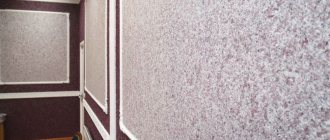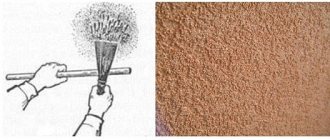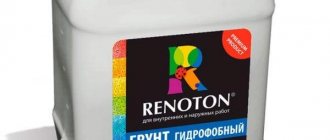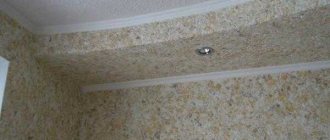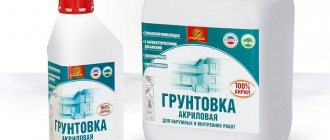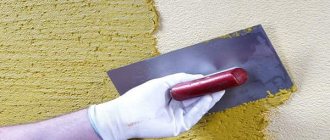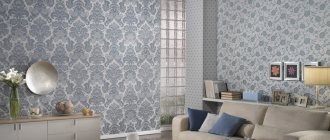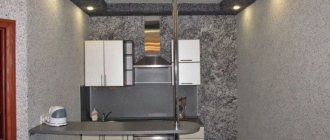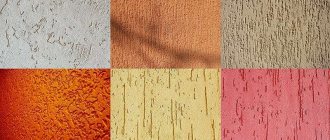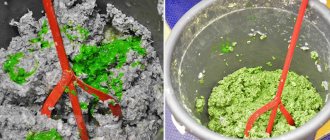What is silk plaster
The solution also has a second name - liquid wallpaper. Both names are correct. But there is still a difference that sets silk plaster apart from other types of finishing. It contains silk fibers, which is why this coating is also called velvet. The mixture includes an adhesive base, particles of cotton and cellulose. Sparkles may be added.
Blue silk plaster Source stroy-podskazka.ru
What is silk plaster
Liquid wallpaper and silk decorative plaster are the same material. Both the first and second names are considered correct. The second name is used to distinguish this particular type of wall covering from the range of liquid wallpaper. The only difference from ordinary liquid wallpaper is that wet silk plaster contains artificial silk fibers. Because of the silk filler, the wall covering is called nothing less than velvet plaster.
In addition to silk, the dry mixture contains water-soluble glue flakes, cotton fibers and cellulose. Various glitters and plasticizers are also added to the mixture.
Types of silk plaster
Wet silk effect Source pratta.ru
Crinkled silk effect Source otdelkasten.com
Smooth silk effect Source otdelkasten.com
The coating differs in texture, composition and the resulting effect. The most popular varieties are:
- wet silk;
- crushed silk;
- smooth silk;
- under a stone;
- under the tree;
- with marble chips;
- Venetian texture;
- rain;
- broken stone.
Liquid silk with wood effect Source twoidvor.com
Liquid silk with marble effect Source stroy-podskazka.ru
Silk with Venetian texture Source vivatdecor.com
Plaster with rain effect Source interiorcom.ru
Plaster with the effect of broken stone Source granitexpert.ru
All these types differ in the method of application to the walls:
- Crushed silk is obtained by applying another layer of coating on top of the base layer using uneven movements. You can use a sponge for this action. After 20 minutes, the surface must be leveled with a spatula.
- Wet silk plaster is created using circular patterns made with a roller. The base layer should be a Venetian trowel.
- The classic version is similar to the previous one, but the second layer of silk must be smoothed out. This happens through slow, smooth movements.
- A structured surface will be achieved if you use the right pressure and ensure that the tool moves easily.
- Rain means angled application. The coating is applied with intermittent movements using a special device.
Textured silk plaster is used to apply colored patterns. The result will look like wet painting. An ornament is created using colored paste. It is best to practice applying drawings on areas of the wall near which pieces of furniture will be located.
Silk-like decorative plaster: manufacturers
photo from the site https://decorkraska.kz/
Despite the fact that China has held the leadership in the production of silk fabric for many centuries, this country is practically not represented on the market for plasters of the same name. The Italians, who are the traditional standard in the production of finishing materials, although they occupy their niche, have not become the undisputed favorite either. Most often you can find products from the following brands in stores:
- SILKOT - produced in Japan;
- SENIDECO - French manufacturer;
- BAYRAMLAR and SILKOAT are Turkish companies;
- SAN MARCO – for admirers of Italian products;
- RODNIK-ART is a domestic company;
- SILK PLASTER – produced in Russia;
- OPTIMIST-ELITE – also of domestic origin.
photo from the site https://www.decorasart.ru/
Decorative plaster with a silk effect from Russian companies has an affordable price, and, in general, has no complaints about the quality. The color palette provides a wide selection of shades, allowing you to choose one that suits any interior. Tinting is possible both manually and by machine.
photo from the site https://myshtukaturka.ru/
Keep in mind that the layer of applied plaster is very thin, and a dark-colored wall will shine through it, distorting the selected tone. Some manufacturers recommend pre-tinting the wall with paint or base, a tone darker than the chosen one, and only after that proceed with plastering. Others allow application to white plaster or putty.
Coating textures
Silk plaster can be of different textures and densities, it depends on the density of the coating, the method of its application, as well as the characteristics of the composition and consistency. The coating can be quite smooth or velvety. In the first case, the plaster contains thin threads, dyes and metal pigments. The pattern acquires a voluminous effect due to inclusions of mother-of-pearl, which sparkle and shimmer on the walls. Unlike liquid wallpaper, silk plaster is created from astringent acrylic polymers, as well as polyester fibers and quartz chips. The most important ingredients are cotton threads and cellulose. Plasticizers extend the life of the mixture.
Plaster with wet silk effect Source stroidominvest.ru
Coating care
The coating is electrostatic and does not attract dust, so from time to time it is simply carefully cleaned with a vacuum cleaner with a soft brush attachment.
You can repair the damaged area yourself. To do this, moisten it generously with water and remove the soaked finish with a spatula. If there are deep damages, they are puttied and primed.
Then they dilute the mixture remaining after the repair and carefully seal these areas with it. If the work is done correctly, there will be no traces of repairs left on the wall.
Variety of shades
The palette of silk plaster is represented by a huge number of available colors. The basic tone is white, there are also standard shades - silver, golden, milky, beige, peach, grayish, light blue, pale pink. There are colors in the palette for bright interiors - options of green, burgundy, orange, yellow, turquoise, blue, brick and sand tones. You can choose cool grayish shades or warm mint, coral, caramel and lilac. It all depends on the imagination and sense of taste of the designer.
Blue plaster Source remont-decor.in.ua
Composition and features of liquid wallpaper
The dry mixture is packaged in 1 kg bags
They are made on the basis of cellulose flakes (paper), glue and various fillers (flocks): cotton, polyester or silk fibers, as well as glitter, which gives liquid silk a shimmering effect.
The particle size varies - the larger the fibers and flakes, the more impressive and prominent the decor looks.
Liquid wallpaper is used exclusively for interior decoration. They are applied to the ceiling or walls. To create an original interior, you can combine plaster with other materials, such as decorative stone.
The advantages of silk plaster include:
- Easy to apply. The job requires special skills or special equipment.
- Possibility of processing any surfaces. The solution applies evenly and firmly to various materials: wood, concrete, drywall and others.
- Fire safety and non-toxic. The substances included in the mixture are not flammable. The components do not emit harmful fumes, so liquid wallpaper can be used to decorate a nursery.
- Maintainability. If a section of the wall is dirty or scratched, peel off the coating from the problem area and apply a new portion of the solution - after hardening, the restored part will not stand out.
- No seams or joints.
- Versatility and attractive appearance. Liquid wallpaper of this type looks impressive in rooms decorated in any style.
- Plastic. After drying, the high-quality composition forms a soft and elastic coating that is resistant to cracking and shedding.
Expert opinion
Alexander Guryanov
Plasterer and decorator
Important! This type of coating does not tolerate contact with water well, so it cannot be used for finishing rooms with high humidity. In addition, due to the property of liquid wallpaper to absorb odors, it is not recommended to cover kitchen walls with it.
Advantages and disadvantages of silk decorative plaster
Silk plaster has many advantages:
- Easy to use material. The mixture is quite easy to prepare at home - you just need to add water to the dry product. You can also apply it to walls yourself. It can be difficult to cover protrusions and irregularities with liquid wallpaper, while silk plaster fits perfectly on any surface.
- Durability and wear resistance. The walls will retain their appearance for about 10 years.
- Health safety. The coating does not contain harmful substances and does not emit toxic fumes. The absence of solvents allows the use of liquid silk even in children's rooms. Another advantage of the material is protection against mold formation and fire resistance.
- Ease of restoration and restoration. Individual sections of the coating can be easily removed and replaced, this will not in any way affect the quality of its operation. Moreover, the repaired area will look the same as before the replacement. Deleted material can be saved. After drying, it can be used again.
- Wide selection of decor. Silk decorative plaster allows you to add various dyes and inclusions to the mixture. As a result, the material acquires completely new properties; with its help, beautiful patterns and designs are obtained.
- Versatility of use. The coating can be used in any type of room. It is applied not only to walls, but also to the ceiling, as well as certain areas of the interior, for example, columns and ledges.
- Heat retention and noise protection. Significant thickness protects the room from the spread of sounds, noise and drafts. The room becomes much more comfortable.
Gray plaster Source stroidominvest.ru
There are also disadvantages to the coating:
- The high cost of silk plaster, which is not inferior to expensive varieties of wallpaper.
- Requires skill in coating. To achieve a decent result, you must have skills and experience in application.
- The material tends to absorb odors, so it is not recommended to use it in the kitchen or dining room.
- Easily damaged. Even an accidental rough touch can remove the coating. The good news is that restoring its integrity is quite simple.
Pink plaster Source travelerscoffee.ru
From the information above, we can draw some conclusions - silk plaster is ideal for those people who are not put off by the high cost of materials and the difficulties in applying them. But such a coating will highlight the advantages of the interior in the best possible way and will allow you to create a unique design on the walls of the room.
Where is it best to use this coating?
The uniqueness of the application technology and the strength of the composition make it possible to use this finish for application to floors and ceilings in various types of rooms. The finish will look beautiful in:
- corridor;
- hallway;
- children's bedroom;
- hallway;
- office;
- and even in the home library.
The look of the finished cladding will give the interior a complete, elegant look.
Eco-friendly and clean raw materials do not contain harmful components. During operation, no substances harmful to health in the form of toxins will be released from the surface.
Important
Antimicrobial additives prevent the material from rotting or deteriorating. There is no room for fungus or mold on such walls. You can apply wet silk even in a bathroom with constant evaporation.
The coating is antistatic, does not electrify, and does not attract dust particles. The surface will look neat anywhere. The material covers the most dangerous areas of the room. For example, in your home, wet silk will look beautiful in the hallway where many people pass.
If the walls are slightly deformed, the coating will remain intact: the plasticizers included in the composition will prevent the cladding from deforming or cracking. After applying the base layer, you can shape the surface so that it appears in the form of a plain canvas or a pattern according to the sketch.
How to apply silk plaster using the wet silk method?
The application method differs depending on the type of mixture and the desired effect. The finishing technology may be different, but the main steps are always performed the same way. Silk plaster must be applied and distributed correctly to obtain the desired result. Only in such a situation can you obtain a durable and stable coating that will last for many years.
Silk plaster in the room Source travelerscoffee.ru
Application step by step:
- Preparation. Its stages will be discussed below.
- Preparation of the solution. Usually the mixture is bought ready-made, but in some cases you need to make it yourself. In such a situation, you should refer to the manufacturer's recommendations. After mixing the solution, you need to leave it for a while so that it acquires its properties.
- Creating a base layer. This is a very important moment that can be done in various ways. The composition can be applied with a trowel, creating a uniform coating. Another option involves using an ordinary roller. The third method involves using a roller to paint the wall. The instructions for the mixture will definitely tell you which method and material should be used in each specific case.
- Actually silk plaster. The solution is applied using a trowel; the size of the tool depends on the desired effect. When the coating dries a little, you must immediately apply a second layer with a certain texture.
How to do it yourself?
The composition of wet silk decorative plaster includes fibers:
- cellulose;
- silks;
- cotton
This is a textured mixture that is easy to apply. To prepare the mixture, you do not need special techniques, just universal tools. Excellent wall finishing is ensured by observing proportions and correct application of the material to the surface.
To make decorative wet silk, you need:
- polyester;
- cellulose fibers;
- cotton;
- natural or artificial silk fibers;
- acrylic additives.
To prepare the working solution, you need:
- Measure the amount of warm water indicated on the package and mix with the powder mixture.
- Pour the liquid into a large container, first add additives from small bags into it, and then add the contents of the package with plaster.
- Mix with your hands, breaking up any lumps, and leave for 10–12 hours.
Acrylic additives are used as an adhesive element.
Attention
Silk fibers (artificial or natural) must first be dyed in the desired color. It is selected based on preferences and combinations in the interior. Acrylic additives will affect the quality and appearance of the finished work.
Silk components give the plaster the shade that is intended according to plan. Their uniform distribution in the composition is very important. After adding the necessary additives, stir the mixture vigorously and thoroughly:
- To do this, use spatulas that well break up the lumps formed on the surface.
- You can shake the mixture in special flasks by tapping, but first you need to stir the composition by hand.
You can use small or large silky fibers. Their effect will be different. Depending on the desired picture, you should make your choice. Larger particles will give a sparkling effect during the daytime and when the light is on.
Preparation for application
Before starting work, you should prepare the walls for coating. There is an opinion that silk plaster easily hides all defects, but still this material does not apply to specialized solutions for such cases. Particular attention should be paid to the surface of the walls - they must be completely leveled, processed and primed.
White plaster Source stroika-tovar.ru
Sequence of work:
- Preparation before plastering. This is a standard process - removing grease, dust, dirt and remnants of the old coating. This can be done using a vacuum cleaner and chemicals.
- Using cement plaster for leveling. Will help hide significant surface imperfections.
- Finishing with putty to remove minor defects.
- Prime the wall for good adhesion.
- An additional layer of solution will be needed for porous areas of the room.
Wet Silk plaster and its disadvantages
By applying a decorative coating that imitates silk to the walls, you can be convinced that it has much more positive qualities than negative ones. There are only a few disadvantages, and the main one is the high cost. The second disadvantage, although easily corrected, is high moisture absorption. To prevent the surface of the walls from absorbing water like a sponge, it is recommended to cover it with acrylic varnish or special wax; however, this will somewhat reduce the illusion of silk, but the walls can be washed.
Finishing
Stages of final work:
- it is necessary to understand that the solution cannot be applied in one layer, as happens with liquid wallpaper. The silk surface involves several layers.
- The base coat should be fairly thin, no more than a few millimeters.
- The solution must be applied in small portions, but quickly enough, evenly distributed over the entire wall.
- movements must be made chaotic in order to form a spectacular ornament on the surface.
- You will get wet silk if you leave a thin base layer.
- For the finishing layer, textured rollers are suitable, which will help create any patterns.
- a contrasting pattern is made using a special roller with a pattern.
Compatibility with other types of coatings
To facilitate repair work, silk plaster is sometimes applied to the previous coating. Such actions may cause the new material to peel off. There is no point in covering wallpaper with liquid silk, since the paper base will simply fall off from exposure to moisture, and the non-woven fabric will completely dissolve.
Insufficient vinyl adhesion will cause the new coating to fail. But if you remove the remnants of the wallpaper, the silk plaster will fit well on the painted surface of the wall. Irregularities and damage must be carefully primed and covered with putty. If water-soluble paints were used, then liquid silk cannot be used.
Outdated and cracked paint must be removed from the surface. Wood walls that are varnished cannot be treated. Ceramic and plastic cladding is also not intended for such actions. But still, the ideal solution would be to completely clean the surface of the walls and thoroughly remove old wallpaper and paint residues. Only in this case will decorative silk plaster look great and decorate the room for a long time. The beauty and elegance of a velvet or smooth coating will create a unique look and become the main highlight of the room.
How to apply: wall or ceiling application technique
Required Tools
Regardless of the methods of applying wet silk decorative plaster, you will need the following tools:
- Spatulas. Tools must have rounded edges. Such spatulas do not leave grooves on the wall or ceiling.
- Trowel. This instrument must be Venetian. Its size will depend on the surface area and pattern.
- Roller. An accessible tool that plays the role of an assistant at all stages of laying the surface layer.
- Containers for preparing the solution. This should be a basin that is used in construction and mixing mortars.
- Drill and mixing attachment. The tool is necessary for working with large volumes.
You also need to have protective gloves, a respirator, material for covering furniture, a bucket of water, small, medium and large rags, safety glasses and masking tape.
Pre-prepare the surface for work. This stage does not require meticulousness with this type of coating, since the texture of the composition hides all irregularities and inaccuracies after drying:
- Firstly, it is good to clean the wall or ceiling from peeling parts. The surface may remain uneven, but is smooth enough for application of the material.
- Secondly, remove any remaining dust or dirt on the surface. Use a soft cloth to go over all slopes and uneven areas. Dry the walls well if necessary.
Primer
For priming you will need to take a construction roller and a flat brush. These tools significantly speed up the processing of the base. The walls must be well prepared in advance: cleared of construction debris and dried.
Select a deep penetration primer taking into account the type of base. Depending on the surface on which the composition is intended to be applied, further manipulations are performed.
Walls can be:
- concrete;
- wooden;
- or from plasterboard.
For example, concrete bases absorb more primer than plasterboard. Wood can absorb one layer of primer, or it may require more extensive impregnation. It is better to take compounds with a penetrating ability of up to 1 cm. These compounds will level the structure of the base and strengthen the walls themselves.
A primer with quartz chips is optimal: it creates a rough crystalline lattice on the surface, which allows the decorative plaster to last as long as possible. Begin the treatment with a generous application of primer in one layer. When it dries, you can coat the walls a second time.
For dark surfaces it is good to have white primer on hand. Due to the white tint of the primer, there will be no distortion of the color of the wet silk that is applied to the base. The second layer takes longer to dry. But you need to get a dry surface before you can start working.
Base coat
The first layer of application is also called the base coat. This is the most important stage of work, which can be performed in several ways:
- The first method is to apply the composition with a large trowel. In this case, you do not need to create patterns, but simply let the layer dry well.
- You can apply a layer with a regular roller. This method is easy and does not require additional explanation.
- Third, paint is used as a base layer, which is rolled out with a medium-sized roller. The composition can vary to a different consistency, but the main thing is to leave the layer unchanged in structure. To do this, saturate the surface evenly, while helping with available tools.
- The base layer is the restraining base for the remaining layers. It is applied in a thin layer with a spatula and trowel. Tools should be at an angle, movements should be smooth and careful. After applying the first layer, the surface is left to dry for 2–3 hours.
Second layer
The second layer is applied in a similar manner to the first. But this layer should not be allowed to dry out, since the relief needs to be formed immediately:
- The trowel makes arc movements, which will create the main pattern. The resulting pattern should be slightly smoothed.
- If some mixtures require a one-time application of a layer over the entire surface to be treated, then wet silk plaster can be applied in stages. The edges of the area are left with unevenness.
- The mixture layer is applied with a short-nap roller. The required area is completely covered with a non-uniform layer of the mixture. It should fit without flaws and completely fill the space.
- Then take a trowel to smooth the surface. This is done with jerky movements, which form the selected texture.
You cannot use a roller with long pile for work, as it absorbs a thick layer of the composition, which is then very difficult to distribute along the desired path.
To create a velvet surface you need:
- Apply the solution in a not very thin layer, and use a trowel to make movements in the form of random strokes.
- Then you can begin to create the required texture. They go over the coating with a trowel again, but this time not with chaotic, but with jerky movements without strong pressure on the wall or ceiling. The trowel will constantly clean off excess layers, which are removed with a medium-sized spatula.
Painting and final stage
A middle layer of plaster is applied to the trowel and a neat stroke is made from the junction of the wall and the ceiling. The corners of the walls are processed with slow movements both horizontally and vertically. Apply the composition in a very thin layer, then spread it well around the perimeter of the required area of painting.
Stages of work:
- First, the joint along the wall and ceiling is plastered. Then they move to another area and gradually follow the square along the junction of the walls just below the previous one.
- Return to the top of the wall. After applying the coating to the entire planned surface, the mixture is allowed to dry thoroughly.
- The second layer is applied in the same sequence.
- When the next square is completed, you need to return to the plastered area in front of it. On a dried, but not completely dry surface, sweep the trowel across the entire wall with chaotic movements. The result will be an iridescent silk pattern, which can be aligned in some parts at your discretion.
- After the second layer has dried, the wall is polished or ironed. The tool is used to work on a slightly set surface and smooth out the smallest roughness.
- Polish the coating with a clean trowel or trowel, repeating the same movements used to apply the 2nd layer. When polishing, you need to apply a little force to achieve a clearly visible gloss.
The process of applying material with photos and videos
Silk plaster in the interior of a room
How to apply silk plaster correctly? The order of applying the mixture is arbitrary; hold the trowel at an angle. The first layer should be no more than 2 mm. When processing corners, it is advisable to use a corner spatula to avoid defects in the work. Moving the spatula outward, we form the corners. Masters apply strokes to the surface as follows:
- Using the “moon” technique, we make circular movements with the tool.
- The “droppe” method is chaotic small strokes.
- Using a roller with various attachments, we can achieve the effect of crinkled silk, velvet, or velor.
- Using a stencil you can make a relief design.
The second layer is final, it is advisable to make it as thin as possible. Then the effect will be amazing.
Crinkled silk effect technology description
The described decorative plaster allows you to create the effect of crushed silk on the wall. As with the previous effect, the entire process from preparation to creation of the coating will be similar. There is no point in describing it, just briefly recall the stages.
- Preparing the walls.
- Preparation of the mixture.
- Base layer.
- Crinkled silk - the effect is achieved using a sponge. Apply the composition and when it dries a little, apply a sponge, which will create the effect of crumpled fabric.
The same result can be achieved using ordinary plastic film. The film is applied to a still dry surface and is removed from it almost immediately. As a result of such actions, the solution may begin to show through in some places, so you should carefully choose the color of the substrate.
Video. Master class effect of crinkled silk.
Surface preparation
Basic preparation is necessary for walls that have already been covered with decorative layers:
- The old coating is completely removed and the surface is cleaned of dirt and dust.
- The entire area is checked for hidden defects. The presence of voids and peeling areas should not be allowed.
- Restoration measures are carried out with acrylic putties.
- If painted surfaces cannot be completely cleaned, they are washed with water and greasy stains are removed. To create better adhesion, cover with numerous scratches. The glossy effect is removed with sandpaper.
- The primer is applied in two layers, each given time to dry completely.
Work is carried out at wall temperatures above 10 -15 degrees and air humidity no more than 80%.
